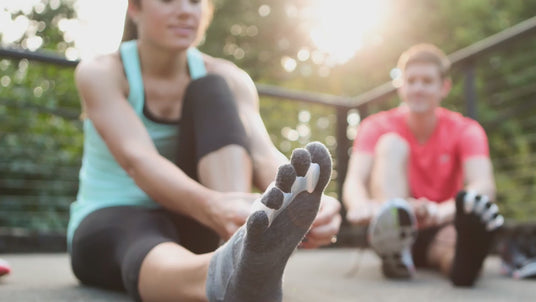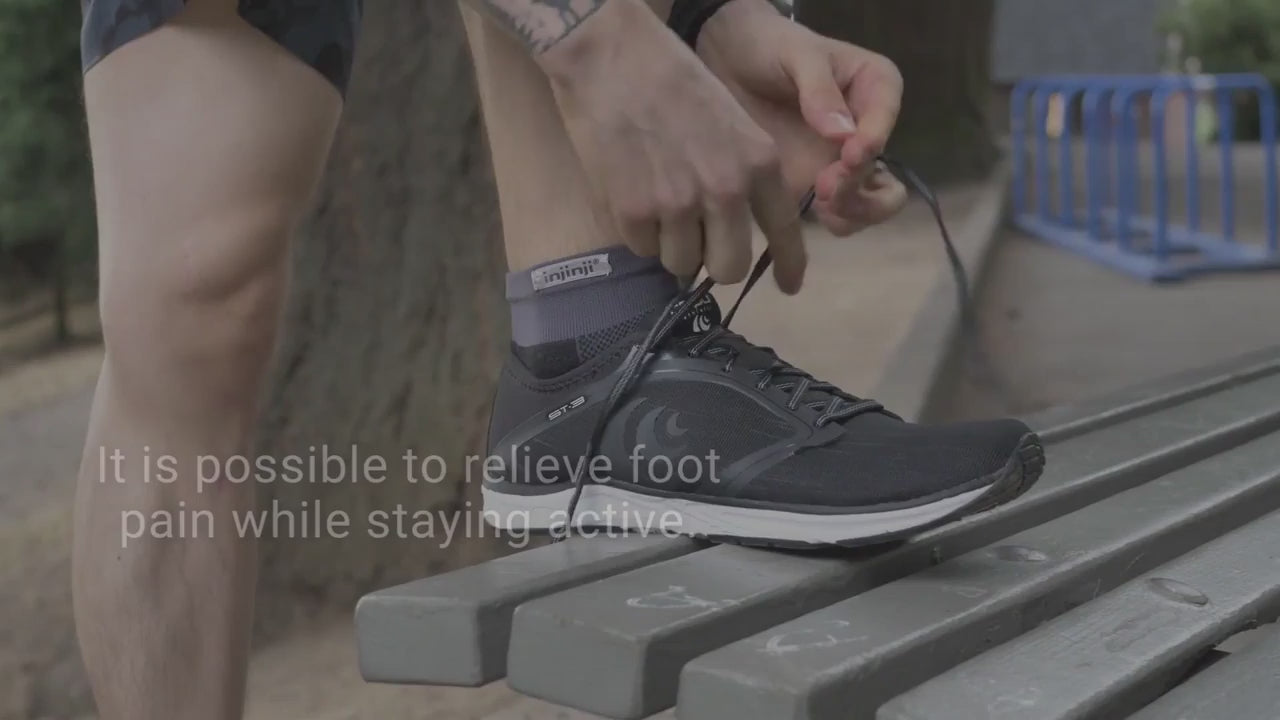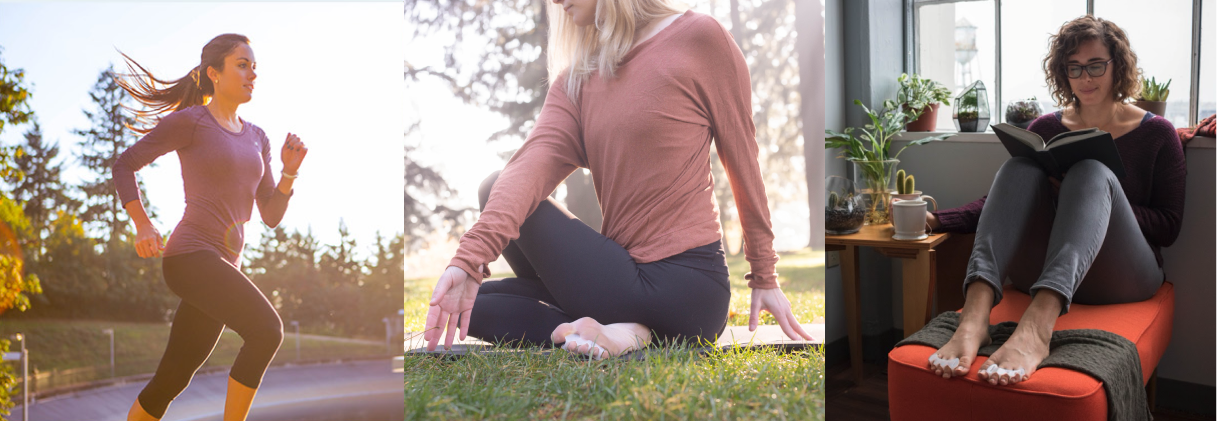Correct Toes® The Original Toe Spacer
For 25 years, Correct Toes® has been helping people align, strengthen, and restore their foot health without surgery or invasive treatments, curing the most common foot conditions:
Invented by Dr. Ray McClanahan, DPM, Correct Toes® are a device made from flexible, medical grade silicone designed to encourage your toes back into their natural alignment.
- Relieve foot pain while being active
- Align toes to their natural position
- Improve strength of the toes and foot
- Increase circulation to the ends of the toes
- Enhance balance and stability
Causes, symptoms, and treatments of common foot conditions:
Bunions
Bunions
Causes
Bunions are first and foremost shoe induced; babies are not born with bunions. This deformation slowly and progressively forms as the individual wears footwear with a tapered toe box. A common misconception is that bunions are hereditary, and while the bunion itself is not genetic, there are certain soft tissue principles that can impact bunion development within family lines. For example, genetic factors control foot width, as well as soft tissue flexibility and integrity, leading conventionally shaped footwear to have a greater impact on individuals with wider feet.
Signs & Symptoms
Bunions are an often painful condition that can lead to instability of the 1st ray and the medial longitudinal arch. Some of the most frequently experienced signs and symptoms associated with bunions, besides pain, include:
- Redness and/or callus formation around the bunion
- Numbness
- Bursitis
Natural Remedies & Treatment
Bunions often respond to conservative care measures and should always be treated by a qualified healthcare professional in a timely and appropriate manner. Conservative treatment for bunions usually involves the following:
- Aligning the toes with toe spacers for bunions like Correct Toes
- Performing range of motion exercises and tissue releases like the Bunion Stretch
- Wearing shoes that are flat, flexible and widest at the ends of the toes.
Crooked Toes
Crooked Toes
Causes
Inappropriate footwear is the leading cause of different types of crooked toes. Footwear with elevated heels, rigid soles, tapered toe boxes, and toe-spring forces toes into unusual positions, encouraging muscle or tendon imbalances. Curved toes may be associated with past foot trauma.
Signs & Symptoms
The most frequently experienced symptoms associated with crooked toes include:
- Toe pain, burning, or irritation when wearing shoes
- Skin thickening
- Inflammation and redness
- Toe contracture
Natural Remedies & Treatment
A podiatrist or other appropriate healthcare professional can provide strategies to help reduce the progression of your crooked toe problem or advise adductovarus toe treatment. Physical therapy, toe joint manipulation, and stretching of the muscles and tendons surrounding toes may provide some reduction of the deformity. Common treatment strategies for this health problem include:
- Toe Extensor Stretch
- Metatarsal Pads
- Footwear that is flat, widest at the ends of the toes, and flexible
- Aligning toes with a toe-spacer like Correct Toes
Neuroma
Neuroma
Causes
Nerves become symptomatic if deprived of bloodflow or if compressed. The enlargement of a nerve is a protective response to ongoing compression and friction when the forefoot is squeezed within conventionally shaped footwear. These symptoms are magnified if the shoe also elevates the heel and lifts and squeezes the toes. In addition to unnatural footwear, other factors that may contribute to neuroma include:
- Bunions, hammertoes, and other forefoot problems
- Excessively high foot arches
Signs & Symptoms
- Some of the most common signs and symptoms of a neuroma include:
- Burning, stinging, stabbing, or shooting pain
- Tingling of the forefoot or toes
- Foot cramping or numbness
- The sensation that you are walking on a lump
Natural Remedies & Treatment
Naturally shaped footwear that is flat, widest at the ends of the toes, and flexible. This will prevent squeezing and compression to already irritated nerve.
- Toe spacers for Morton’s neuroma, like Correct Toes, increases the volume and space between the toes
- Metatarsal Pads will encourage top-of-foot lengthening and relaxing
- Stretches like the Toe Extensor Stretch or Hammertoe Stretch
Plantar Fasciosis
Plantar Fasciosis
Causes
While commonly known as Plantar Fasciitis, an early 2003 study by Dr. Harvey Lemont, DPM confirmed that there is no inflammatory cause or involvement in this condition. Rather, the cause plantar fascia pain is due to a lack of consistent blood flow to the plantar fascia by the tibialis posterior artery.
This artery is limited or shunted as the big toe (Hallux) is compressed and elevated in modern-day footwear and running shoes. Additionally, when the foot is consistently supported in conventional footwear, muscles atrophy and lengthen, placing additional stress and impact on the plantar fascia.
Rather than being ‘too tight’ the plantar fascia is chronically extended, and needs to be relaxed.
Plantar Fasciosis is prolonged when improperly treated with methods that assume inflammation. Treatments like Ice, Stretching, The Strasborg Sock, Night Splits, etc. will further cause the plantar fascia to strain, and don’t address blood flow.
Signs & Symptoms
Common signs and symptoms include pain, and tenderness of the plantar fascia, primarily following periods of inactivity or rest when blood flow is decreased.
Natural Remedies & Treatment
For a comprehensive understanding about Plantar Fasciosis and Cure details, check out “Treatment of Plantar Fasciosis,” written by Dr. Glenn Ingram, ND and our own Dr. Ray McClanahan, DPM. A brief list of treatments include:
- Naturally shaped footwear that is flat, widest at the ends of the toes, and flexible. This will prevent stretching the bottom of the foot and allow for natural toe alignment.
- Correct Toes help naturally position the Hallux, toe spacers for plantar fasciitis decrease strain on the plantar fascia and compression on the tibialis posterior artery.
- Metatarsal Pads will encourage top-of-foot lengthening and relaxing of the plantar fascia
- Stretches like the Toe Extensor Stretch to relax the plantar fascia
Hammer Toe
Hammer Toe
Causes
Hammertoes are the result of a muscular imbalance between the long extensor tendons across the top of the foot, and the short arch intrinsic muscles and flexor tendons on the bottom of the foot. With years of wearing conventional footwear where the heels are elevated, toes are lifted up and squished together, the lesser toes are held in an unnatural position. Shoes that are too small may also force your toes into a curled position. Over time, your toe tendons adjust to this positioning, causing your toe or toes to hold a hammered shape. While commonly seen within family lines, a hammertoe is not innately genetic. There is, however, a genetic component for the ability of certain tendons to become contractured and tight if held improperly within footwear.
- Pain at the top of the bent toe from footwear pressure
- Pain at the base of the toe, at the metatarsophalengeal joint
- Corns on the top of your bent toe
- Redness and swelling in your affected area
- Decreased joint range of motion in your affected toe joints
Signs & Symptoms
Hammertoe flexion may be reducible or flexible, and can also be very stiff or rigid. The following symptoms can be experienced in both a flexible or rigid hammertoe;
- Pain and inflammation, commonly located at the base of the 2nd toe
- Redness of the skin overlying your affected joint
- The sensation that you are walking on a stone
- Nerve sensations like burning, stinging or numbness
Natural Remedies & Treatment
Conservative treatment may be helpful, or fully corrective for a flexible hammertoe.
- A Correct Toes toe spacers for hammertoe will encourage natural alignment of the toe
- Metatarsal Pads will encourage top-of-foot lengthening and relaxing
- Stretches like the Toe Extensor Stretch or Hammertoe Stretch
- Avoiding any stretch or motion that lifts the toes into dorsiflexion. (ex. lunges, squats, and certain yoga positions)

Correct Toes® The Original Toe Spacer - Aqua / Extra Small is backordered and will ship as soon as it is back in stock.
Couldn't load pickup availability
Download the Owner's Manual
Download the Owner's Manual
Customers are saying
Risk-Free Guarantee
We offer a 30-day-no-worries return policy, with a 90-day materials warranty, if they split or break during use. You may also return Correct Toes within 30 days, even if they have been used or modified.
Read full policy here.
The Correct Size™ makes it easy to size yourself without leaving this page.
Click on the blue "Find Your Correct Size™ above the color selection, and it will walk you through it in just 15 seconds.
**If you’re still not sure which size you need, you can submit a photo in the Correct Size™ bar
We also have an easy-to-use, printable Correct Toes sizing template below:
Step 1: Print the Correct Toes Template
Before printing, please note that this document is 8.5 inches x 11 inches. Be sure to print “actual size”.
Download the Correct Toes Sizing Template
Step 2: Cut Out the Template and Test it on your toes
Using the sizing pattern, position point Ⓐ at the webbing between your big toe and 2nd toe of your right foot.
Keep point Ⓐ in place, while you check the alignment of point Ⓑ with the webbing between your 4th toe and pinky toe. Here’s how you can determine the proper fitting of your Correct Toes toe spacers:
Step 3: Ensure that you’re comfortable with the fitting
To confirm if you already scored the proper fitting, spread your big toe and pinky toe outward, aligned to the toe spacer pattern, as if the spacer is actually between your toes. How does the stretch feel?
Correct Toes flex, and won’t spread toes quite as far as you pull them in this step. If the stretch hurts, try a smaller size or consider modification.
Check the width and girth, do your middle 3 toes fit between the spacer indicators?
Toe Spacers For Healthy Naturally Shaped Feet
Unlike other brands in the market, Correct Toes toe spacers are designed with medical grade silicone and engineered to be worn over toe socks, inside of regular socks, and in conjunction with natural footwear.
Wearing toe spacers during activity can improve foot function, enhance posture, and reduce the risk of injury by ensuring your toes are properly aligned and supported.
-
Best Fitting to Your Size
The 4 different sizes ensure a better fit than other brands.
-
Wear Barefoot or in Shoes
The improved fit allows you to wear them in applicable shoes.
-
Soft and Durable Material
The medical-grade silicone offers both comfort and durability.
-
Built for An Active Lifestyle
Best design and sizes for all-day wear for the best results.

Modify Correct Toes
Watch this short video to learn the options for modifications that make these toes spacers customizable to fit your feet perfectly.
Common Questions
What will wearing Correct Toes do?
What will wearing Correct Toes do?
With Correct Toes, you can:
- Relieve foot pain while being active
- Align toes back to their natural, anatomical position
- Improve strength and flexibility of the toes and feet
- Increase circulation to the ends of the toes
- Enhance balance and stability
How do they work?
How do they work?
Correct Toes help splay the toes in the way that nature intended.
Why is this important?
We spend a lifetime in footwear that is too narrow at the ends of the toes. As a result, the shod adult foot shape differs from the unshod adult foot shape (and from the foot shape of infants, who are born with perfect feet).
Correct Toes work in a similar way to how braces work for teeth. Correct Toes place the toes into optimal alignment and slowly and progressively change the architecture of the foot.
The muscles of the foot adapt and strengthen accordingly. Toe alignment and foot strength has numerous positive effects on biomechanics, gait and injury prevention.
How to wear toe spacers?
How to wear toe spacers?
Correct Toes are placed between the toes and are designed to be worn either barefoot or within naturally shaped footwear.
Best results occur when using Correct Toes during daily weight-bearing activities.
It’s important to incorporate Correct Toes into your foot care routine slowly and progressively.
Begin wearing Correct Toes for only 30 minutes the first day, increasing wear-time in 30-minute increments each consecutive day, to tolerance.
Correct Toes encourage muscles to flex, move and work in new ways. Fatigue, muscle soreness and tenderness are normal during the transition process. Similar to any new activity, soreness should subside while strength gains occur.



















